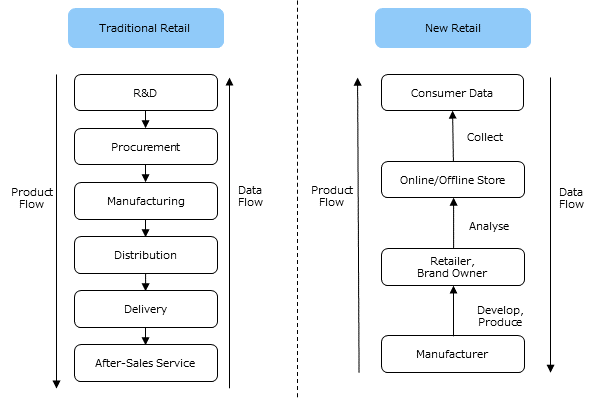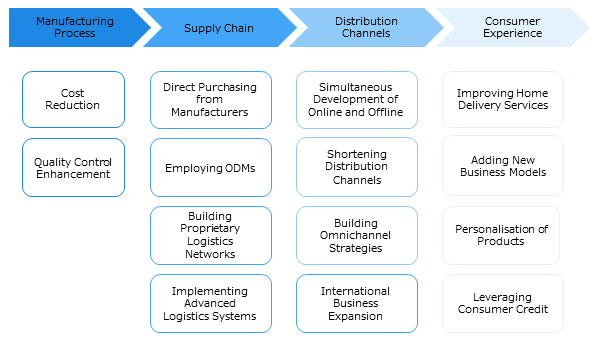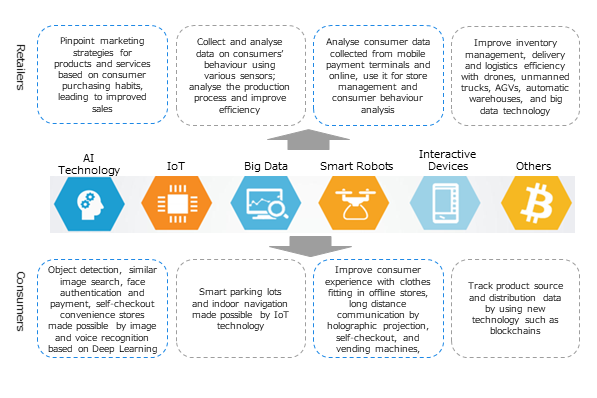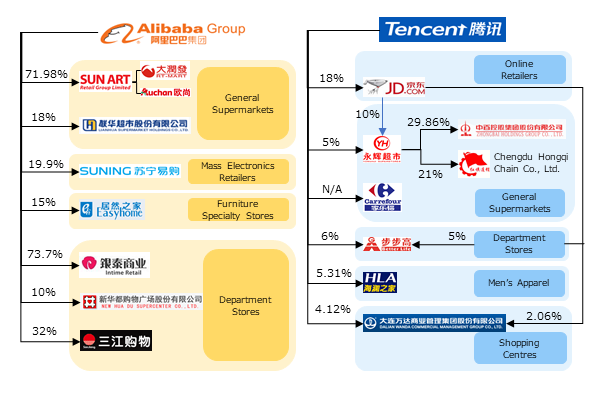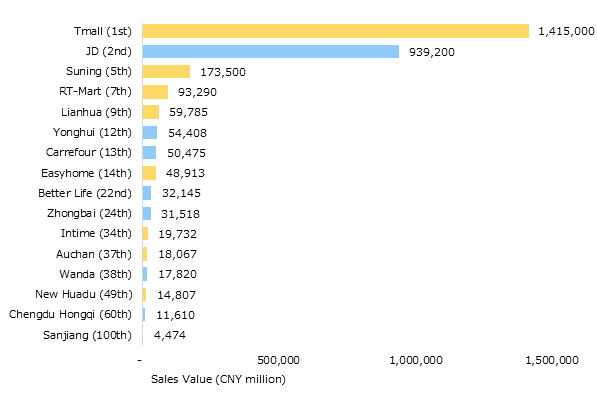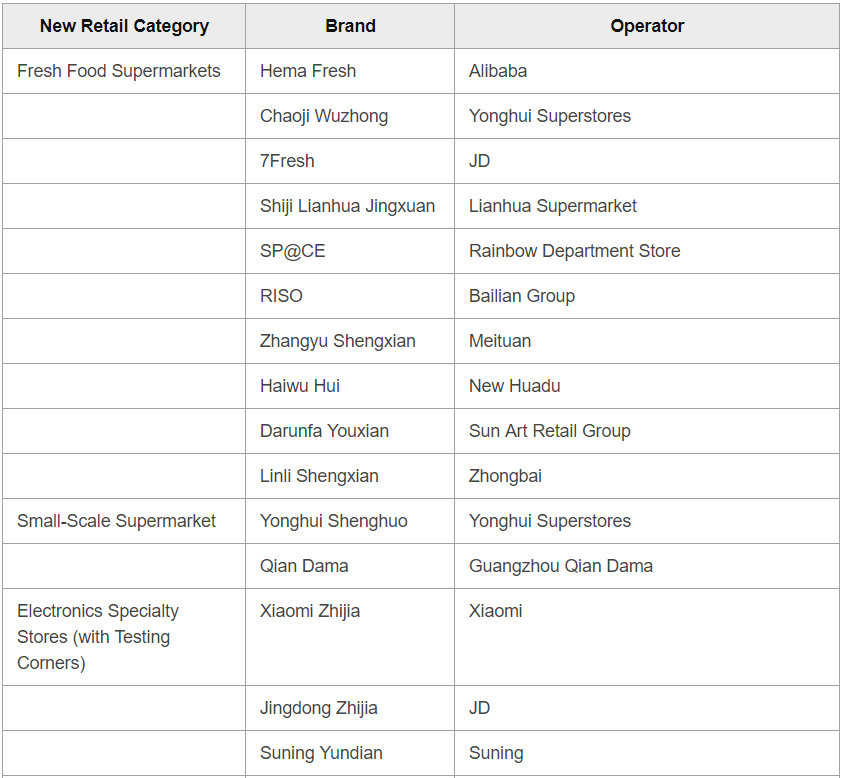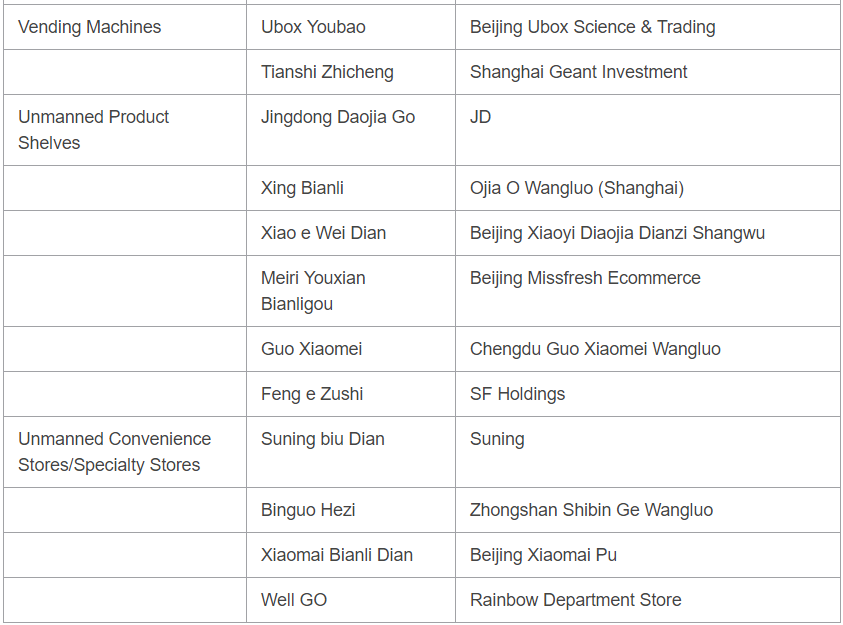The Next Generation of Retailers at the Helm of the Chinese Market
|
The Chinese retail industry has witnessed tremendous growth in recent years due to the rapid development of online retailers and the spread of internet technologies. However, as the country’s economic development has also spurred new levels of awareness amongst consumers, they are now seeking different consumer experiences and services. |
|
In order to meet this growing domestic demand, online and offline retailers have been establishing mutually beneficial partnerships to create new retail forms based on the latest technology. This report covers the background behind the development of a new retail form named “New Retail”, as well as its business model, the application of related technologies, and general trends amongst representative companies. |
|
Background Behind New Retail Development |
|
”New Retail”: New Form of Retail Combining Online and Offline Operations with Focus on People, Goods, Warehouses, and Logistics |
|
”New Retail” is a concept proposed in October 2016 by Yun Ma (Jack Ma), the Executive Chairman of the Alibaba Group. It refers to a new form of retail that merges online (the internet) and offline (brick-and-mortar stores) operations and focuses on “people, goods, warehouses, and logistics”. After the term was coined, various retailers and e-commerce companies announced their adoption of this new retail model, and the interpretation of the term New Retail has expanded to include any new retail forms that upgrade the supply chain based on such technology as big data and AI, along with integrating online stores, brick-and-mortar stores, and logistics centred on consumer experience. |
|
The development of this new retail form is attributed to three factors. The section below will provide an analysis of these factors from the perspectives of the retail industry itself, consumers, and technology. |
|
Customer Acquisition Costs Rise Along with Declining Growth Rate in the E-Commerce Market, While Offline Store Retailers Show Signs of Recovery |
|
The e-commerce market in China is rapidly growing with tremendous momentum due to such factors as the popularisation of the internet and smartphones, as well as the high convenience of online shopping. According to the China Electronic Commerce Report by the Ministry of Commerce (MOC), the transaction value of the domestic e-commerce market expanded at a CAGR of 56.7% over 2008–17 to around CNY 7.18 trillion, boasting the largest market size in the world. According to the Thirteenth Five-Year Development Plan for the E-Commerce Industry, the e-commerce market size is expected to reach CNY 10 trillion by 2020. However, despite the fact that the market is expanding, the growth rate has been continuously decreasing since 2014, and is expected to be moderate compared to the past speed. At the same time, customer acquisition costs are higher than the average customer spending and raising concerns amongst e-commerce companies. For this reason, e-commerce operators have been seeking a cornerstone for new growth and launched the New Retail strategy, which aims to fuse retail stores and e-commerce. |
|
Online Retail Value in China (YoY Growth) |
|
|
|
Source: Compiled by UZABASE based on MOC, “China Electronic Commerce Development Report” |
|
Alibaba: Average Gross Profit and Acquisition Cost per Active User |
|
|
|
Source: Compiled by UZABASE based on company filings and materials from Haitong Securities and IYIOU |
|
While the share of e-commerce in China’s retail industry has increased from about 1% in 2008 to 20% in 2017, brick-and-mortar stores still play an important role in the retail industry as a whole, and each company is trying to take the initiative in this enormous market and promote the New Retail business model that merges e-commerce and offline stores. |
|
Going forward, the retail industry is projected to display solid growth. In fact, the sales growth rate of 100 retail companies (department stores, supermarkets, and specialty stores) under MOC’s special monitoring was 2.8% in 2017, up by 3.3 percentage points YoY from -0.5% in 2016. Retailers operating offline stores are showing signs of recovery, and the shift in China’s economic model from the traditional dependency on investments to consumption-driven type is projected to boost solid growth in the retail industry. |
|
Detailed data shows that the total retail sales of social consumer goods increased at a CAGR of 14.5% over 2002–17 to reach CNY 36.6 trillion. According to the MOC’s forecast, the total retail sales of social consumer goods are projected to continue growing at a CAGR of 10% over 2016–20 to reach CNY 48.0 trillion by 2020. |
|
Retail Sales of Social Consumer Goods |
|
|
|
Source: Compiled by UZABASE based on data from China Bureau of Statistics, MOC |
|
Growth Rates of GDP and Total Retail Value of Social Consumable Goods |
|
|
|
Source: Compiled by UZABASE based on data from the National Bureau of Statistics of China |
|
Revenue Growth Rate of 100 Major Retailers |
|
|
|
Source: Compiled by UZABASE based on data from the China National Commercial Relations Center |
|
Consumer Preferences Shifting from Cheap Products to Branded Items, Higher Quality, and Experience-Based Services, While Growth Prospects Are Turning Gloomy for Low Cost-Oriented Retailers |
|
Consumer preferences are changing along with the continuous growth in income for Chinese citizens. As consumer psychology is developing, consumers in China have started to value a diverse range of characteristics, putting more emphasis on quality and convenience rather than the price of goods and services, while also pursuing the quality of life and the sense of joy, as well as self-expression through personalised products and services. Even in the e-commerce industry, which has developed based on its characteristically low pricing, the purchasing behaviour of online shoppers has changed from impulse buying to reasonable consumption. In fact, according to a consumer survey conducted by China National Commercial Relations Centre, online consumers put more emphasis on brands and quality rather than price in 2016. In addition, the degree of interest and acceptance for the latest technologies is also very high in this audience, especially amongst young people. |
|
However, due to this change in consumption trends, existing offline store retailers and the e-commerce industry are still unable to meet some of consumers’ demands. For example, store retailers lack a rich assortment of goods, comparison between brands, and home delivery services for products. On the other hand, in the e-commerce industry, it is difficult to convey the merits of goods and services, as it is not possible to check them beforehand, and the process from purchase to the actual arrival takes some time. The lack of a response from the retail industry to such diversification of consumer sentiment has spurred the nascence of New Retail. |
|
Disposable Income Per Capita in Urban Areas |
|
|
|
Unit: CNY |
|
Source: Compiled by UZABASE based on data from the National Bureau of Statistics of China |
|
Consumer Preference Ranking (2016) |
|
|
|
Source: Compiled by UZABASE based on the China Electronic Commerce Research Centre, “China Consumer Network Consumption Insight Report and Online Shopping Guide (2016)” |
|
Note: The survey was conducted in the form of a multiple-choice questionnaire. |
|
Number of Online Shoppers Has Increased Sharply Due to the Spread of the Internet and Smartphones, Forming the Customer Base for New Retail |
|
The proliferation of the internet and smartphones is projected to become a major driving force to support the spread of New Retail. It relies on attracting the younger audience, who is more sensitive to information services, consumption convenience, and service quality. According to statistical data from the China Internet Network Information Center (CNNIC), the number of internet users in China reached 770 million as of 2017, with the penetration rate at 55.8%. Of them, the number of mobile internet users reached 750 million, accounting for 97.5% of total internet users. Furthermore, according to the China Academy of Information and Communications Technology (CAICT), the number of domestic shipments of mobile phones in China was 490 million units as of 2017, of which smartphones comprised 460 million units. A breakdown by communication functionality reveals that shipments of 4G mobile phones also reached 460 million units. |
|
Number of Internet Users |
|
|
|
Source: CNNIC, “Statistical Report on Development of China Network” |
|
With the spread of the internet and smartphones, the number of online shoppers is moderately growing in China. According to the CNNIC, the number of online shoppers reached 530 million in 2017, of which the number of mobile users reached 500 million people. |
|
In this way, through the popularisation of mobile internet, consumers have gained the ability to shop anywhere at any time. In addition, it also gave a start to a new purchasing experience including the use of electronic payment services at brick-and-mortar stores and the use of coupons via mobile phone applications. Due to factors including these developments, e-commerce operators are trying to enter the offline retail industry, offering new services based around mobile internet, and trying to promote inflows into brick-and-mortar stores. These online shoppers who access stores from their mobile phones are forming the customer base to support the development of New Retail which tries to eliminate the boundary between e-commerce and offline stores. |
|
Number of Online Shoppers |
|
|
|
Source: CNNIC, “Statistical Report on Development of China Network” |
|
Business Model |
|
New Retail Aims to Create Data-Driven Businesses by Digitising Products and Customer Information |
|
New Retail is also defined as a data-driven form of retail, whereby all information on products and consumers is digitised, aggregated, and analysed in order to be used for the development of products and services and the improvement of operations. In this process, it is considered important to implement electronic tags (RFID tags) and develop membership systems (point cards, etc.). The introduction of RFID tags enables retailers to confirm inventory status, manage the freshness of perishables, and visualise customer movement within the store in a way that is best suited for cameras and sensors installed. In addition, implementing a membership system allows operators to analyse the purchasing histories of each individual consumer and provide better recommendations and high value-added offerings. While the traditional retailing industry only exhibited a passive function of selling products researched and developed by manufacturers to customers, New Retailers accumulate consumer information in databases through in-store sales and e-commerce, and are able to offer the most suitable services to their customers by utilising the data they gather and actively working with manufacturers on their own. |
|
Consumer Data Is the Most Important Driving Force in New Retail |
|
|
|
Source: Compiled by UZABASE |
|
Establishment of Omni-Channel Retailing Is an Important Step for Crafting a Seamless Purchasing Experience for Consumers |
|
The establishment of omni-channel retailing is considered essential for the fusion of e-commerce websites and brick-and-mortar retail, which is a major characteristic of New Retailers. Creating an omni-channel approach that enables retailers to stay in touch with consumers anywhere, regardless of whether it is a store, an event, an online channel, or a mobile channel. This approach allows consumers to receive a seamless purchasing experience, while retailers are able to obtain the full range of information on these consumers and leverage it for predicting consumer needs and developing promotion strategies. Furthermore, since distribution through intermediaries is rendered unnecessary, the rationalisation of order management reduces operating costs and helps develop products that are competitive in terms of pricing. It also leads to the suppression of delivery costs, such as by allowing customers to order items online and then pick them up at a store, or using store inventory for fulfilling delivery orders. From such a point of view, each company is rushing to build omni-channel strategies as an important step to connecting e-commerce and offline stores. |
|
New Retailers Simplify and Expand Distribution Channels |
|
|
|
Source: Compiled by UZABASE |
|
Note: The traditional retail distribution channel is marked with a black outline, while the New Retail distribution channel is outlined in blue. |
|
Item Delivery Efficiency Greatly Improved Through the Introduction of Third-Party Logistics Platforms by New Retail |
|
One of point about New Retail that has been garnering attention is whether significant improvement in the delivery efficiency of goods can be achieved. Particularly, the reduction of the delivery cost for perishables which normally have high management costs, delivery area and time are regarded as important issues for the future development of New Retail (transportation costs for perishables are estimated to be about 4–5 times higher than those of usual products). Currently, joining third-party distribution platforms and building proprietary logistics systems are considered to be the most efficient ways to reduce these costs. |
|
Third-party logistics platforms are represented by Cainiao Network Technology (Cainiao) under the umbrella of Alibaba. Alibaba began establishing a distribution system network called “China Smart Logistic Network (CSN)” in 2013 in order to meet the substantial delivery demand generated by e-commerce retailers. It partnered with Intime Retail, Fosun, and Forchn, as well as logistics companies SF Express, STO Express, YTO Express, ZTO Express, and Yunda, and established Cainiao, which currently manages a cloud-based logistics platform. This platform allows subscribed companies to track the status of their trucks and warehouses in real time, optimally distribute cargoes, and calculate the optimal route by leveraging big data and cloud computing technologies, making it possible to cut delivery time and cost. |
|
Amongst retailers who have their own logistics systems, JD, an e-commerce operator, and Suning, a home electronics mass merchandiser, are most well-known. These two companies have integrated warehousing, transportation, delivery, customer service, and after-sales service by constructing logistics centres, delivery stations, and transportation networks in major regions of China to improve the efficiency and quality of their respective logistics units. In 2015 and 2016, Suning and JD successively opened their logistics network to retailers and converted it to a third-party logistics platform. |
|
Shift to New Retail: Focal Points for Each Stage of the Value Chain |
|
|
|
Source: Compiled by UZABASE |
|
Technology Application |
|
Implementation of Latest Technologies in Retail Industry Is Accelerating, Expected to Improve Operation Efficiency |
|
Currently, e-commerce operators and offline store retailers are accelerating the implementation of the latest technologies such as AI, IoT, and big data. For example, consumer data collected from a mobile payment terminal at an online or offline store is used for the analysis of consumers’ age, preference for products, price sensitivity, and consumption power, as well as for the development of recommendation functionality and new products, pinpoint marketing, and other techniques. In addition, it is also used for formulating business strategies such as determining the optimal location for new stores, developing promotional campaigns, adapting to the flow of customer traffic, and improving ordering and inventory management through aggregating sales data for each store, which is thought to lead to profit improvements. |
|
In addition to big data, e-commerce companies provide quick and punctual logistics services through the use of smart logistics (drones, automatic guided vehicles, automatic warehouses, etc.) which implements technologies such as AI, IoT, and smart robotics. In particular, during large sales including China’s “Singles’ Day” (an online sale held on 11 November) when a large volume of items require delivery within a short timeframe, traders accumulate the expertise for transportation and increase efficiency. For example, delivery time for around 100 million items ordered for Singles’ Day was shortened to 2.8 days in 2017 from 9 days in 2013. |
|
Introducing Latest Technology Important for Raising Consumer Satisfaction |
|
From the consumers’ point of view, customer engagement can be increased through introducing elements of entertainment to the shopping experience by installing interactive devices inside stores and implementing Deep Learning technologies within mobile applications. Furthermore, speech and image recognition technologies allow consumers to search for similar products, compare prices, and detect objects; they also provide an abundance of product information that consumers require when purchasing items, and enable them to try on closing through the use of AR technology or conduct long-distance communication between stores by holographic projection, which leads to quicker product selection. In addition to this, the introduction of payment services using facial recognition as well as mobile payment services makes highly secure and quick payments possible. |
|
As such, retailers are expected to continue promoting the use of latest technologies in developing new retail forms with the aim of improving consumer satisfaction and operating efficiency. |
|
Impact of Latest Technology on Retailers and Consumers |
|
|
|
Source: Compiled by UZABASE |
|
Performance Trends of Representative Companies |
|
Major E-Commerce Operators Aim to Advance to Offline Retail, Actively Engaging in Strategic Alliances with Traditional Retailers and Investing in These Companies |
|
Since end-2016, Alibaba and Tencent have accelerated their advance into the offline retail store market. Alibaba made a series of large-scale investments in October 2016, acquiring a number of leading retailers in China, such as Sun Art Retail Group, Intime Retail, and Easyhome. In addition, Alibaba increased its stake to become the second largest shareholder of home appliance mass retailer Suning and supermarket Lianhua Supermarket, showing its ambition to conquer the offline store retail market. Furthermore, Alibaba signed a strategic cooperation agreement with Bailian Group, the largest shareholder of Lianhua Supermarket, aiming for collaboration in terms of supply chains, membership systems, payment services, and logistics systems, based on IT technology such as big data. |
|
Meanwhile, Tencent employs a different strategy: instead of engaging in M&As for management rights, it maximises the usage of its substantial user base and its mobile payment service Wechat Pay, anticipating synergies within the group. Since end-2017, Tencent invested in major companies representing the compartmentalised retail market shopping centre operated Dailian Wanda Commercial Management, general supermarket Carrefour China, Yonghui Superstores, men’s apparel store operator HLA, and department store operator Better Life. In addition, Tencent is the largest shareholder of JD, the second leading Chinese online retailer, and has a strategic alliance with major supermarket operator Walmart, which is also the third largest shareholder of JD. |
|
Leading E-Commerce Operators Develop Their Own Convenience Store Chains, Anticipating Potential Demand Growth in This Market |
|
According to the China Retail Industry Development Report published by the Ministry of Commerce, operators of convenience stores, shopping centres, and supermarkets reported favourable growth in 2016 at 7.7%, 7.4%, and 6.7%, respectively. Meanwhile, growth rate continued to be sluggish for specialty stores and department stores, recording 3.1% and 1.3%, respectively. These trends indicate that both Alibaba and Tencent are focusing on general supermarkets within their own retail groups. At the same time, since convenience stores are demonstrating the highest growth potential, the two companies are planning to develop their own convenience store chains and expand their market shares in the offline retail market. |
|
In August 2017, Alibaba opened “Tmall Xiaodian” offline store in Hangzhou, and plans to expand its franchise to include 20,000 stores by end-2018. In addition, the company is offering support services for the implementation of LST systems incorporating IT technology such as big data for digitising individually owned stores. By using an LST system, owners are able to strengthen their business operations through such tools as the analysis of purchasing behaviour, estimations for products that have high demand, and inventory management. Alibaba aims to introduce this system to 1.5 million individually owned stores within 2018. |
|
On the other hand, Tencent group’s JD launched “JD Convenience Store” in rural areas in 2017, with plans to rapidly expand the size of its network in the same franchise format. JD aims to achieve rapid expansion at a pace of 1,000 new stores per day by end-2018 and plans to increase the cumulative number of stores to one million within five years. |
|
Major Retailers Affiliated with Alibaba and Tencent and Their Holdings |
|
|
|
Source: Compiled by UZABASE |
|
Revenue Ranking of Major Retailers Affiliated with Alibaba and Tencent (2016) |
|
|
|
Source: China General Chamber of Commerce and CNCIC |
|
Note 1: Revenue ranking has been compiled based on “Top 100 Chinese Retailers in FY2016” |
|
Note 2: Companies under the umbrella of Alibaba are shown in yellow, while those under Tencent’s umbrella are shown in blue. |
|
Fresh Food Supermarkets, Unattended Product Shelves, and Self-Checkout Convenience Stores Are Representative Operation Models of New Retailers |
|
Besides tie-ups between the e-commerce industry and offline retailers, independent expansions into the New Retail business by retailers and venture companies are attracting attention. Specifically, these retail models include fresh food supermarkets incorporating restaurant services and delivery, unattended product shelves, and self-checkout convenience stores. |
|
New Retail Categories and Representative Operators |
|
|
|
Source: Compiled by UZABASE |
|
Case Studies |
|
“Hema Fresh”: Created a Novel Business Model as a Successful Example of New Retail |
|
”Hema Fresh” is a fresh food supermarket under the umbrella of Alibaba, which opened its first store in Shanghai’s Jinqiao Ward in January 2016 and released its “Hema” application online on the same day. More than 3,000 products are sold under the name “Hema Fresh”, of which more than 80% are foodstuffs. Items are procured from 103 countries, with the focus on high value-added products being the supermarket’s main feature. Products handled include fresh and packaged vegetables, fruits, high-grade seafood such as king crab, Australian lobster, abalone, and salmon, various types of meat meticulously classified by parts, freshly made bread, and Chinese and international seasonings. |
|
However, the largest competitive advantage of “Hema Fresh” is not the high-quality product line-up, but its innovative service. When ordering from the supermarket online, customers are eligible for free delivery within 30 minutes if they are located at a distance of 3 kilometres or less from the supermarket. When ordering from an offline store, customers are provided with a purchasing experience that includes having their purchased products cooked on the spot, and enjoying a meal in the restaurant area. In addition, “Hema Fresh” supermarkets offer unusual sights such as store clerks arranging items in the same order as the online store and a special shopping bag carried to the delivery area by a system of hangers attached to the ceiling. This helps customers experience the unique model of “Hema Fresh”. Naturally, Alipay (Alibaba’s electronic payment service) can be used for mobile payment, but customers can use the “Hema” application with Alipay for self-checkout in offline stores, in addition to cash, simplifying the payment processing environment. |
|
This type of retailing has gained popularity amongst consumers, and “Hema Fresh” continues to expand in scale. There were 38 supermarkets as of March 2018, of which 15 were in Shanghai, 10 in Beijing, and others in Suzhou, Hangzhou, Fuzhou, Ningbo, Guiyang, Shenzhen, and Chengdu. The number of stores in Beijing and Shanghai is expected to exceed 30, and the total number of “Hema Fresh” supermarkets in China is expected to reach 100 by end-2018. |
|
Strengths of “Hema Fresh” |
|
|
|
Source: Compiled by UZABASE |
|
“Chaoji Wuzhong” Attracts Consumers by Offering New Lifestyle |
|
”Chaoji Wuzhong” is a composite supermarket offering “goods + food and beverages” under the umbrella of Yonghui Superstores. Its first outlet opened in Fuzhou city, Fujian Province, in January 2017. “Chaoji Wuzhong” not only provides high-quality fresh food, but also offers various products and services such as dining services, electronic products, and household goods, and has its own strategy to provide a lifestyle as a package. Currently, the company has about 16 kinds of retail booths, and each store has booths tailored to 8 to 9 basic lifestyles (refer to the image below). These retail booths also differ depending on the location of each store, with designs of stores differing between those located in residential areas versus those in commercial facilities. As for the operation method, just as “Hema Fresh”, “Chaoji Wuzhong” supermarkets offer online purchasing (using “Yonghui Shenghuo” application), home delivery service (via a logistics company under JD’s umbrella), and dining services. |
|
”Chaoji Wuzhong” had 39 supermarkets as of April 2018, and it aims to exceed 100 by end-2018. “Chaoji Wuzhong” supermarkets are mainly concentrated in Fuzhou and Shenzhen, but also operate in 10 cities such as Beijing, Shanghai, Chengdu, Xiamen, Nanjing, Hangzhou, Chongqing, and Putian. |
|
Management Forms and Main Products of Supermarkets Under the Umbrella of “Chaoji Wuzhong” |
|
|
|
Source: Compiled by UZABASE based on company filings |
|
Summary |
|
Amidst the full-scale upgrade of China’s retail industry, consumer preferences have shifted from being mainly focused on low prices to brands, quality, and experience-based services. In addition, technologies such as AI, IoT, and big data have also developed, providing improved operation efficiency, new services, and expanded applications in new consumption scenarios. Underpinned by such factors, a new retail form that fuses online and offline retailers was born. Compared to traditional retailers, New Retailers are developing data-driven businesses by digitising information, providing seamless purchasing experiences through the creation of omni-channel strategies, raising operational efficiency, and improving consumer satisfaction by applying latest technologies. Currently, new retailing forms deployed in China are typically fresh food supermarkets incorporating dining services and delivery, as well as unmanned convenience stores utilising image recognition technology and RFID tags. Major players include leading e-commerce operators such as Alibaba and JD, in addition to supermarket operators such as Yonghui Superstores. Furthermore, online and offline retailers have been actively concluding partnerships since end-2016, aiming to expand market shares and harness synergy effects. |
|
New Retailers in China are currently at the formative stage and presenting a range of various possibilities; at the same time, some areas of uncertainty still remain in terms of profitability and sustainability. The future evolution of the current retail industry and new types of retail forms to be created are calling for attention in this market. |













